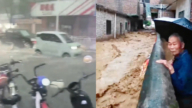【新唐人2013年06月03日讯】根据中共当局的计划,中国将以“三峡大坝”为样板,在全国范围内建成50个大型水坝。然而“三峡大坝”营运10年后,对当地生态环境的破坏,以及三峡工程弊大于利的后果已经有目共睹,也一直受到专家的指责。目前中国已是世界上最大的水电消费国,再大兴水坝,外界认为,除了在增加GDP数字上好看一点外,最后可能给中国子孙和整个世界留下更多的遗患。
据了解,中共当局计划在2020年以前,把中国的发电能力提高50%,同时削减煤炭消耗并减少对进口天然气的依赖。中国未来十年新一轮的水电项目,有50个大型水坝正在运作中。这些大坝大多分布在中国地震多发的西南山区。世界上泄洪量最大的“溪洛渡大坝”,计划在今年6月开始发电。
五月中旬,中共环保部批准的,位于四川藏区的“双江口大坝”,将是世界上最高的水电大坝,高达314米。
北京环保学者张峻峰认为,现在再大力建设水电站,除了在GDP数字上显得好看一些外,没有其他好处。张峻峰指出,水利发电并没有解决因燃煤带来的酸雨等环境问题,反而带来移民及当地用工等诸多问题。
北京环保学者张峻峰:“水能一般都在山区,尤其是水源的上流地带或发源地区,而这些地方在中国一般都是地质薄弱地带,在这些地方建水利发电设施,一定会改变当地的地质结构,造成地震的问题,山体滑坡的问题,泥石流、水土保持等等一些问题。甚至会毁坏一些当地的传统文化。”
目前最受争议的是,有五座大坝将建在流入缅甸和泰国的怒江之上,这些大坝可能影响毗邻喜马拉雅山脉地区的独特动、植物种群。批评人士对此表示担忧。
中共当局今年三月,计划在雅鲁藏布江修建三座大坝,印度总理辛格表示担心。
张峻峰:“在上游地区建设这种大坝,当地的生态系统已经适应了几万年,几亿年的生态系统,就要转换成现在人工的生态系统,这样对当地的生态造成一个严重的破坏,冲击影响会延续几千年,上万年,这样的影响有的是不能消除的,所以下游的国家担忧也正常。”
不过,中共媒体还是盛赞“三峡大坝”的好处,实际上,三峡工程的发电量,离当初的设想相差甚远,三峡发电量仅占全国总发电量的3.3%。
旅德学者王维洛指出,在三峡库区范围内,天然河道被淹没,导致至少102亿立方米具有蓄洪能力的自然河流消失,防洪库容也没有达到预期的防洪库容300亿立方米的效果。
而位于三峡地带的“沐抚大峡谷”是世界第四大峡谷,目前已经发生多处断裂。
三峡工程在国际上被认为是最危险的工程,中国的水利专家黄万里曾经指出“三峡工程12大危害”,警告三峡工程最终面临炸掉的后果、三峡工程将遗患子孙。
旅德学者王维洛表示,目前,三峡水库中的泥沙淤积量约为19亿吨,三峡工程运行三十年后,泥沙淤积量将超过40亿吨,长江水无法将那么多泥沙带入大海,必然堵塞中下游河道,那时想炸掉三峡大坝也解决不了问题。
采访编辑/刘惠 后制/周天
Chinese Communist Party New Plans For 50 Large Hydropower Dams
The Three Gorges Dam is the model from the
Chinese Communist Party(CCP).
Now for their latest plan of 50 large hydropower dams.
After 10 years in operation, the Three Gorges Dam has
caused destruction of the local ecological environment.
The results are more harm than good and the aftermath
is obvious to the public and blamed by experts.
China is the world’s largest consumer of electricity and water.
Experts say that more hydropower construction will only pretty
up the GDP figure, but leave troubles for future generations.
The CCP has planned to increase power generation
capacity by 50%, while reducing coal consumption and
relying on imports of natural gas.
Currently in China, 50 large hydropower dams are under
construction, mainly in southwest earthquake-prone regions.
The Xiluodu dam, the largest in the world in terms of flood
discharge capacity, is scheduled to produce electricity in June.
In mid-May, China’s Environmental Protection Ministry
approved construction of “Shuangjiangkou dam”.
The project, located in Sichuan, will be the world’s
highest hydroelectric dam, up to 314 meters tall.
Zhang Junfeng, Beijing environmental scholar, comments:
“More hydropower construction will benefit nothing
but boost the GDP figure”.
Zhang indicates that hydropower has not solved
acid rain caused by coal combustion.
It has generated a great number of problems, including
local resident migration and construction labor employment.
Zhang Junfeng: “Sources of hydropower are mostly in mountain
areas, where in China are mainly geological weak sections.
In these areas, hydropower construction will surely
change the local geological structure.
It may trigger earthquakes, landslides, and impact
soil and water conservation, and other problems.
To some extent, it may even destroy local traditional culture.”
Currently, the most controversial projects are five dams
to be located over the Nu River.
This flows from China, through Burma and Thailand.
Critics are worried that these dams may affect the populations
of animals and plants living in adjoining Himalayan areas.
In March, the CCP decided to construct
three dams over the Brahmaputra River.
Indian Prime Minister Manmohan Singh has
expressed concern over this plan.
Zhang Junfeng: “Large dams will be constructed
in the upstream areas.
The local natural ecological system has actually lived
through tens of thousands of years or even longer.
Now it will be changed into an artificial ecological system.
This is a serious damage to local ecological system, the impact
of which may last for thousands of years and possibly longer.
Some of the impact cannot be wiped out. So it’s normal
reactions if the countries downstream express their worries.”
In contrast, the CCP official media have highly touted the
benefits that the Three Gorges Dam have generated.
However, the dam’s actual generating capacity is
a far cry from the original vision.
The Three Gorges dam’s power generation accounts for
only 3.3% of the total output in China.
Germany-based water specialist Wang Weiluo has said
that in the Three Gorges reservoir area,
the natural river courses have been flooded
causing disappearances of natural rivers, which
have a flood storage capacity of 10.2 billion cubic meters.
According to Dr. Wang, the reservoir’s flood control capacity
hasn’t reached the expected 30 billion cubic meters.
Mufu Grand Canyon, located in Yangtze Three Gorges,
is the 4th largest canyon in the world.
The canyon has been found with multiple surface ruptures.
Internationally, the Three Gorges dam has been
considered the most dangerous project.
China’s renowned hydraulic expert, Huang Wanli,
pointed out “12 hazards of the Three Gorges dam”.
Huang predicted that the project will give rise to
a disastrous aftermath, and will eventually be blasted off.
Wang Weiluo has said that the Three Gorges
reservoir holds about 1.9 billion tons of sediment deposits.
In 30 years time the total amount of silt
will exceed 4 billion tons.
The Yangtze River cannot carry so much sediment into the sea,
so will inevitably clog up the river downstream.
Then, even bursting the dam cannot help solve the problem.




























